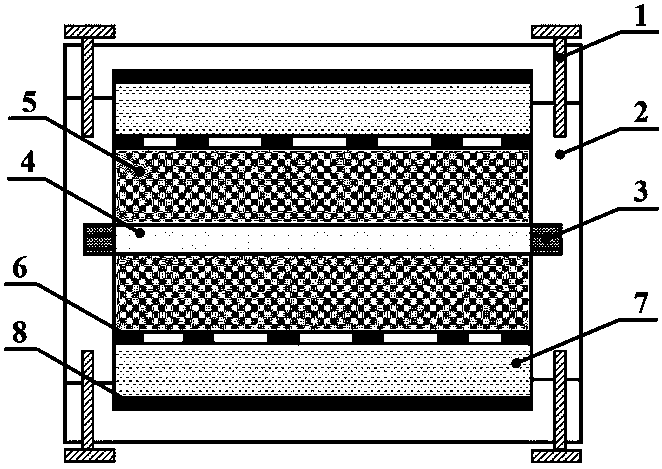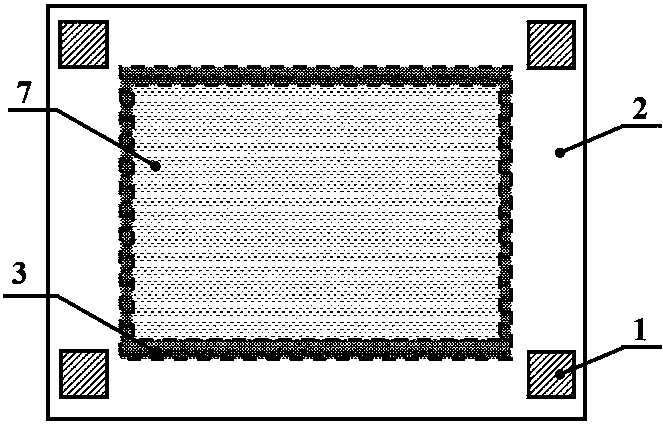Quantum dot radiofluorescence effect nuclear battery
A technology for quantum dots and nuclear batteries, applied in the field of quantum dot radiation-induced fluorescence effect nuclear batteries, can solve the problems of deviation from the optimal value, uncontrollable emission spectrum, and inability to achieve the conversion effect, so as to improve the conversion effect and increase the output. performance effect
- Summary
- Abstract
- Description
- Claims
- Application Information
AI Technical Summary
Problems solved by technology
Method used
Image
Examples
Embodiment 1
[0036] The preparation method of quantum dot fluorescent layer comprises:
[0037] S1. Take methyl methacrylate and polymethyl methacrylate, and magnetically stir evenly at 55°C in a ratio of 7:3, so that the polymethyl methacrylate is completely dissolved and configured into a sol;
[0038] S2. Vacuumize at 0.6Mpa for 1 hour to remove the dissolved air in the sol, and place it in a dark place for 24 hours until the chemical properties of the sol are stable.
[0039] S3. In the glove box, mix 2,5-diphenyloxazole, 1,4-bis[2-(5-phenyloxazole)]benzene, azobisisobutyronitrile and CsPbBr 3 Quantum dot materials are added with sol, 2,5-diphenyloxazole, 1,4-bis[2-(5-phenyloxazole)]benzene, azobisisobutyronitrile and CsPbBr 3 The mass ratio of the quantum dot material is 2:0.2:0.2:2:95.6, and it is magnetically stirred at room temperature for 1 hour;
[0040] S4. Pour the sol in S3 into a custom-made steel mold. The size of the custom-made square steel mold is 30 mm*30 mm*1 mm. Afte...
Embodiment 2
[0049] The preparation method of quantum dot fluorescent layer comprises:
[0050] S1. Take methyl methacrylate and polymethyl methacrylate, and magnetically stir evenly at 60°C in a ratio of 6:4, so that methyl methacrylate is completely dissolved and configured into a sol;
[0051] S2. Vacuumize at 0.7Mpa for 1.5h to remove the dissolved air in the sol, and place it in a dark place for 24 hours until the chemical properties of the sol are stable;
[0052] S3. In the glove box, 2,5-diphenyloxazole, 1,4-bis[2-(5-phenyloxazole)]benzene, azobisisobutyronitrile and CsPbBr 3 Quantum dot materials were added to the sol, 2,5-diphenyloxazole, 1,4-bis[2-(5-phenyloxazole)]benzene, azobisisobutyronitrile and CsPbX 3 The mass ratio of the quantum dot material is 3:0.3:0.3:3:93.4, and magnetically stirred for 2 hours at room temperature to mix the filler and the matrix material evenly;
[0053] S4. Pour the sol of S3 into a custom-made steel mold. The size of the custom-made square stee...
Embodiment 3
[0062] The preparation method of quantum dot fluorescent layer comprises:
[0063] S1. Take methyl methacrylate and polymethyl methacrylate, and magnetically stir evenly at 70°C in a ratio of 8:2, so that methyl methacrylate is completely dissolved and configured into a sol;
[0064] S2. Vacuumize at 0.7Mpa for 2 hours to remove the dissolved air in the sol, and keep it in a dark place for 24 hours until the chemical properties of the sol are stable.
[0065] S3. In the glove box, 2,5-diphenyloxazole, 1,4-bis[2-(5-phenyloxazole)]benzene, azobisisobutyronitrile and CsPbBr 3 Quantum dot materials are added to the matrix material in step 1, 2,5-diphenyloxazole, 1,4-bis[2-(5-phenyloxazole)]benzene, azobisisobutyronitrile and CsPbBr 3 The mass ratio of the quantum dot material is 4:0.4:0.4:4:91.2, and it is magnetically stirred at room temperature for 2 hours;
[0066] S4. Pour the sol of S3 into a custom-made steel mold. The size of the custom-made square steel mold is 30 mm*30 ...
PUM
| Property | Measurement | Unit |
|---|---|---|
| Thickness | aaaaa | aaaaa |
| Thickness | aaaaa | aaaaa |
| Thickness | aaaaa | aaaaa |
Abstract
Description
Claims
Application Information
 Login to View More
Login to View More - R&D
- Intellectual Property
- Life Sciences
- Materials
- Tech Scout
- Unparalleled Data Quality
- Higher Quality Content
- 60% Fewer Hallucinations
Browse by: Latest US Patents, China's latest patents, Technical Efficacy Thesaurus, Application Domain, Technology Topic, Popular Technical Reports.
© 2025 PatSnap. All rights reserved.Legal|Privacy policy|Modern Slavery Act Transparency Statement|Sitemap|About US| Contact US: help@patsnap.com



